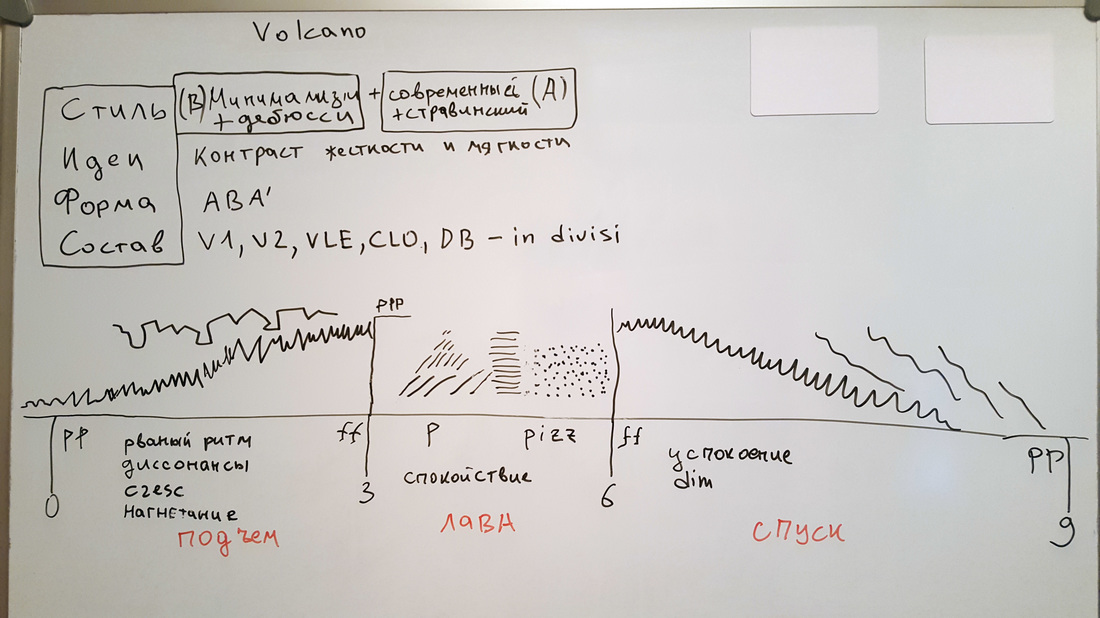When writing this piece I first drew a plan on a whiteboard, you can see it below. Then I added two voice sketches using my smartphone audio recorder.
This piece consists of three parts, each approximately 3 minutes long. It is a program track, as I first created the idea (plan below) and then wrote music. First part (climbing up the volcano) creates an increasing tension by crescendo, speeding up tempo and transition from legato to staccato.
I created multiple videos for this track, including a painting by Lida Naumidis specially for this piece, sketch of this painting and a collection of photos.
First I created an introduction inspired by R. Strauss "Metamorphosen". In the beginning the melody is passed between the voices and the harmony is created totally by voice leading.
Then starting from measure 11 I start to add staccato, continuing voice leading in other parts. This section fades out in measure 24 and a fully staccato section starts, which is gradually built up from lower to upper voices. This is the way I composed it - first the lower voice and then the upper voices.
In measure 30 looking up the volcano is implied, which temporarily increases dynamics. This staccato section was very uniform and I added gradual tempo increase and some 16-th notes.
In measure 60 tension is increased by changing ostinato and adding infinite uniform atonal melody in first violin, built using only quavers without pauses. It ultimately transforms to ostinato crescendo.
After culmination there is a short pause, while first violin prepares harmonic. This pause creates first strong contrast. Second 3-minute part starts with harmonic, which is panned from first to second violin. This 3-minute part uses minimalism, consonances, pentatonic, 5th and 8th intervals. Program meaning of this part is the beauty of lava inside the volcano.
The first instrument, which starts to play minimalism melody is the first violin, because the rhythm and atmosphere is very new and I suggest that first violinist has to show the new approach to the whole group. Then other instruments come in, creating a polymeter - notes are of the same length, but phrases have different number of notes. I use divisi here to increase dinsity and dissolve the rhythm.
Gradually minimal rhythm is slowed down and is replaced with long notes, while some instruments continue to play slowing down minimal melodies, making the transition more smooth. This is approximately the middle of the whole track and it reflects total tranquility (not the most obvious characteristics of lava). Movement dies away for a while and then is gradually restored.
In measure 115 long notes gradually transform into tremolo. Then new more simple minimalistic phrases begin to appear. They are polyrhythmic. At last pizzicato comes in and gradually replaces arco notes.
In pizzicato section the same minimalistic melodies are used, but they get some of their notes replaced with pauses. As more and more notes are being replaced with pauses, rhythm dissolves and pizzicato fades into silence. This pizzicato section depicts smoke and ashes rising from the volcano.
Now a second strong contrast breaks in: after a pause music abruptly returns to staccato atonal texture with fortissimo dynamics. In the last 3-minute part tension gradually decreases due to diminuendo, tempo slow down and descending melodies. Artistic meaning of this part is descending from the volcano. Viola melody from the first 3-minute part repeats here, but now two more instruments accompany it. After this section fades out, another section of staccato with trills starts, which also fades out in measure 206.
The last section is the retrograde of the first minute of the piece with little modifications and with tempo decreased to 50 bpm.
I used 8dio Adagio Strings library (ensemble patches). This library has many variants of legato transitions in a single phrase (multi-legato), but unfortunately, it allows to combine no more than 3 types of transitions, one of which is glissando. Also, one instance of kontakt can hold only one multi-legato instrument (kontakt multi). Due to these limitations the most convenient way to change legato types is to interrupt a phrase and start a new one with a new legato type.
I also found one more drawback of this library: big disbalance between dynamics and sound volume of instruments and articulations. It can be easily fixed - I spent half an hour playing all articulations with the same dynamics (forte) and then checking resulting sound volume in sound editor and tweaking articulation volume in kontakt. I talk about this technique in detail in my video lectures on youtube (Studio+ lectures).
Some articulations of this library are too loud at the lowest level of CC1 and I had to use some amounts of sound volume control (CC11) for smooth diminuendo.
Despite its limitations, the library allows for very good sound due to multiple variants of legato transitions - if you know about its limitations and know how to work with them. This great advantage overbalances all of its drawbacks.

